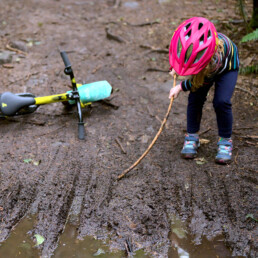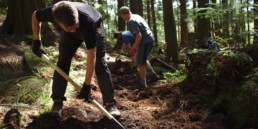Common Trail Building Mistakes
-
- Not Engaging with Key Stakeholders
Trails and trail networks largely exist on public lands and unceded territories in Canada, with a much smaller subset on private land. For long term sustainability, gaining consent from stakeholders ensures that access is protected. This can be an uncomfortable proposition, as simply disclosing the existence of an unsanctioned trail or network of trails could result in their closure. - Building without Context
All trail networks are subject to a variety of social, managerial, and environmental conditions. This local context informs key factors that can mean the same trail in one area can be sustainable while in another area not sustainable. Before undertaking a new project – particularly a trail that might push the limits of durability to enhance user experience – ensure that the additional maintenance is factored in. - Guessing the Grade
Trail grade related issues are one of the dominant causes of trail degradation, either from user mechanics or environmental factors. While purposeful sections of higher grade have their place in the balance between user and environment, more often than not these issues crop up in areas where there isn’t a clear purpose for a higher trail grade. An inclinometer or similar tool can ensure that trails are aligned to best fit the intended user types and abilities; mellow for the green and blues, and steeper for advanced trails. Bonus: careful planning of durable trails with low average grade where necessary mean less overall maintenance work, opening up more opportunities for advanced, technically challenging lines that may require more work. Think of it like Min-Maxing a trail network. - Forgetting the speed
One of the hardest aspects of trail work is the gap between imagining a new line and predicting how it will feel to ride. Underestimating trail speed is easy to do, especially when assessing a trail by foot. When building a reroute, plan to match the flow of the existing trail, paying attention to the transitions on and off of the new section. Bringing a bike along, of course, is also a great way to test out the alignment and make any tweaks as needed
- Not Engaging with Key Stakeholders
Context is important: Who are the users on a given trail, and how do they interact with one another? Answering this question can greatly increase user experience and mediate trail user impact issues.

-
- Half Bench is Half way there
Especially when working alone, the temptation to excavate a bit of soil and tamp it down on the lower side of the trail is too enticing to resist. This is sometimes accompanied by a supporting log on the lower side, parallel to the trail, that dirt is piled onto. This isn’t without its risks however: sloughing or uneven compaction can result in the trail disappearing or channeling water down the trail, resulting in additional erosion. Fully benching the tread has greater stability over time, and the greater width allows for the best ‘line’ to develop over time, which tends to result in a narrow overall width once established. - Building over organics
From large logs buried deep in the soils of coastal western hemlock forests of the south coast of BC to the intensely thick root mats of prairie grasses, dealing with organic materials are a reality for trail building in Canada. Finding the careful balance between realistic amount of effort on one hand and a stable and predictable trail afterwards is important. Look to other local examples to determine how much organic excavation needs to take place, and match the effort involved with the trail and user types. - Task Completion
Sometimes considered secondary to the main purpose of a trail, the finishing cleanup is an important part of user experience that is sometimes missed. Careful replanting of vegetation, proper broadcasting of excavated soils, and dressing the trail corridor with detritus makes a significant impact of visitor experience and can help to cultivate an impression of care and stewardship among the more conservation minded users of our trail systems. - Incomplete Closure
Sometimes the best way to maintain a trail is to reroute it to a better location, resulting in a section of trail that needs to be closed. Reclaim eroded areas with check dams – natural obstacles like logs or rocks that divert the flow of water and soil – and reclaim all closed trails with transplanted native vegetation that conceals the old corridor.
- Half Bench is Half way there



